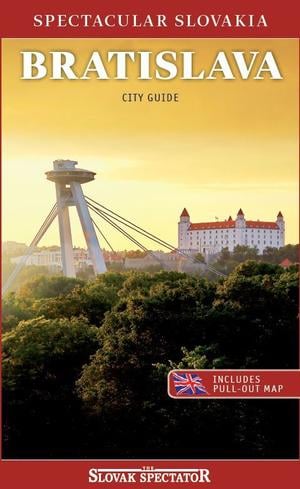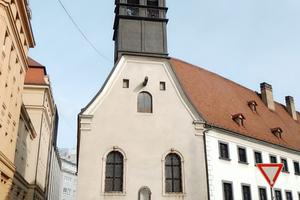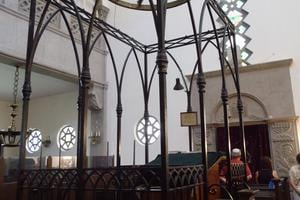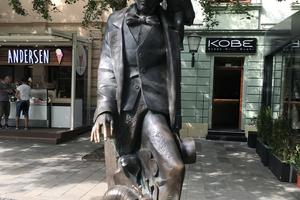You have access to this premium content thanks to ING Hubs Slovakia, the expert hub of global banking.
This article was published in the latest edition of our Bratislava City Guide, which can be obtained from our online shop with Spectacular Slovakia travel guides.
 Lost in Bratislava? Impossible with this City Guide! (source: Spectacular Slovakia)
Lost in Bratislava? Impossible with this City Guide! (source: Spectacular Slovakia)
Bratislava has always been a multicultural city, the result of its location on the crossing of trade routes and close to several national borders. Its traditional composition of inhabitants has typically depended on the current ruling nation and the political situation in central Europe, which has been in flux for many hundreds of years.
Indeed, Bratislava has even changed its name numerous times, with previous generations of locals referring to it as Pressburg, Pozsony or Prešpork and even a period spent as “Wilson’s Town” after the American president Woodrow Wilson. Representatives of every nation have left even more permanent traces on the Slovak capital, and it is often possible to trace these various occupations at numerous sites in the city.
HUNGARY AND AUSTRIA
Along with the former federation with the Czech Republic (Czechoslovakia) Bratislava is most commonly associated with Austria and Hungary which border Slovakia to the west (Austria) and to the south (Hungary). Bratislava spent nearly 300 years as the coronation city and capital of the Hungarian Kingdom, and in addition to the shared history, there are numerous examples of Austrian and Hungarian styled architecture from the period. Many of these date specifically from era of Empress Maria Theresa, who reigned between 1740-80 and oversaw a prodigious period of construction. Several governmental buildings, new palaces and waterworks were all built during these 40 years as the whole town became the centre of social and political life for the empire.
The Austro-Hungarian Empire was composed of several nations, including the countries of central Europe and some of today’s Balkan states. It meant that Germans, Czechs and Croatians have also made their home in Bratislava, as well as a Jewish population whose numbers predictably – and dreadfully – declined during the mid 20th century.
Signs of multiple nations in Bratislava
Železná studienka (Euroarboretum - Partizánska Lúka in the Železná studienka area)
SPAIN, DENMARK AND FRANCE
Spain also has links to Bratislava. In 1631 Mariana of Spain, the youngest daughter of Spanish King Felipe III and Margarita of Austria, married Ferdinand III, the heir of the Hungarian crown. She was crowned, together with her husband, in St Martin’s Cathedral in 1638.
There are several sculptures and plaques in the city to commemorate the visit of numerous famous historical figures or to mark significant events. The Danish fairytale writer Hans Christian Andersen has his statue on Hviezdoslavovo Square; the Czechoslovak president Tomáš Garrigue Masaryk stands in front of the Slovak National Museum; and there is a sculpture of the Hungarian poet Sándor Petőfi in Medická Garden.
Signs of Germany in Bratislava
Museum of Carpathian Germans Culture located in Zuckermandel (www.visitbratislava.com)
Stollwerck factory (www.chocolatewrappers.info)
Home of Segner family
Cintorín Vrakuňa (cemetery)
A statue depicting a Napoleonic soldier leans on a bench in the Main Square and the French presence in Bratislava is also commemorated on a plaque in the Primate’s Palace, recalling the signing of the Treaty of Pressburg in 1805. Diplomats from France and Austria signed it after the battle of Austerlitz, which was won by Napoleon.
POLAND, INDIA AND ITALY
Pope John Paul II visited Bratislava several times after the Velvet Revolution and there is a statue of him in Námestie Jána Pavla in Petržalka, commemorating a 1995 trip, and a bronze relief in the Ursuline Church and Convent in the city centre.
In 1938, Bratislava also welcomed Indian dignitaries. One of the plaques oposite to the McDonald’s at Hviezdoslavovo Square recalls the visit of Pandit Jawaharlal Nehru, with his daughter Indira Gandhi, the leaders of the Indian freedom movement against British rule.
Signs of Hungary in Bratislava
Sculpture of Sándor Petőfi
Museum of Hungarian Culture in Slovakia (www.visitbratislava.com)
The Italian presence in the city is best seen in the artwork of Pálffy Palace and Bratislava Castle, where Italian paintings from the 16th century provide centuries-old clues to cultural ties between Bratislava and Italy. The Church of St John of Matha has frescoes of the Italian baroque painter A. Galli Bibiena, while the mirrors in the Mirror Hall of the Primate’s Palace come from Venice.
JEWISH SITES
Signs of Italy in Bratislava
Frescoes by the Italian baroque painter A. Galli Bibiena in the Church of St John of Matha
The Jewish population of Bratislava is small these days, but there were once vibrant communities in the city, living mostly in the residential area around the castle. The Jewish burial shrine that includes the tomb of Chatam Sófer and the graves of other prominent rabbis and scholars is all that remains of what was once a much larger Jewish cemetery. Some historic buildings have survived: the only remaining synagogue in the Slovak capital on Heydukova Street; the Holocaust memorial on Rybné Square and the old Jewish quarters: Zámocká and Židovská Streets. The Museum of Jewish Culture, located on Židovská Street, was opened in 1994 as part of the Slovak National Museum. Other traditional minorities living in Bratislava have their own museums showcasing their cultures: Croatians have one in Devínska Nová Ves, Hungarians and Carpathian Germans both have museums on Žižkova Street. All of them operate under the Slovak National Museum. The Hungarian minority is the biggest minority in Slovakia and represents 8.5 percent of all inhabitants.
Jewish sites in Bratislava
Museum of Jewish Culture (www.jewishbratislava.sk)
Jewish quarters - Zámocká and Židovská streets
Holocaust memorial - Rybné nám. Square
SLOVENIA, RUSSIA, BULGARIA AND UNITED KINGDOM
Bratislava also has a reputed connection with Slovenia, specifically at Devín Castle. Many Slovenians believe that the castle is connected with the Italian town of Duino, near Trieste, whose Slovene name is Devín and which has a large Slovenian population. Duino is also the setting for a popular Slovenian folk legend “Lepa Vida”.
The former Soviet Union has, of course, also had a significant impact on Bratislava, and there are numerous sites that recall the era of the mid-20th century. None is more obvious than the Slavín monument, which remembers the lives of the 6,845 Soviet soldiers who died during the liberation of Bratislava in April 1945, many of whom are buried in six mass and 278 individual graves. The monument is surrounded by a park containing trees from various parts of the former Soviet Union.
Signs of multiple nations in Bratislava
AUSTRIA: Several sites related to the Austro-Hungarian empire
BRAZIL: Bratislava is the name of a small town in the south of Brazil
BULGARIA: Sakrakopec (between Bratislava-Rača district and Svätý Jur; memorial to the victims on board the Bulgarian “Tabso” plane that crashed here)
CROATIA: Grassalkovich Palace (Presidential Palace) – the palace is named after the Croatian aristocrat Antun Grassalkovich; Museum of Croatian Culture in Slovakia in Devínska Nová Ves
THE CZECH REPUBLIC: Several sites related to the former Czechoslovakia; Statue of Tomáš Garrigue Masaryk Statue in front of the 2 Slovak National Museum; Czech lion - Statue at Nábr. M. R. Štefánika on the square in 12 Eurovea
DENMARK: Statue of Hans Christian Andersen – 9 Hviezdoslavovo nám. (square)
FRANCE: Statue of a Napoleonic soldier; Primate’s Palace - Plaque recalling the signing of the Treaty of Pressburg in 1805 (after Napoleon’s victory in the Battle of Austerlitz)
INDIA: Plaque - Rybárska brána 8; Plaque near a restaurant recalling the visit of Pandit Jawaharlal Nehru
NORWAY: Reduta Courtyard named after Björnstjerne Björnson at the Slovak Philharmonic building (reconstructed partly with funds from Norway); Memorial plaque to Björnstjerne Björnson at Björnsonova Street
POLAND: The Ursuline Church - Bronze relief of Pope John Paul II in the Ursuline Church; Statue John Paul II A statue of Pope John Paul II stands in a Námestie Jána Pavla II. square named after him in Petržalka
RUSSIA: Slavín
SLOVENIA: Devín Castle - Many Slovenians believe that the castle is connected with the Italian town of Duino, near Trieste, whose Slovene name is Devín and which has a large Slovenian population. (www.muzeumbratislava.sk)
SPAIN: St Martin’s Cathedral - Mariana of Spain was crowned in the cathedral in 1638
UNITED KINGDOM: Primate’s Palace - The so-called Mortlake Tapestries in the Primate’s Palace were woven in the UK in 1635; Čunovo - A monument to five British airmen killed when their plane was shot down here in 1944
USA: For a short period in 1919, Bratislava was known as Wilsonovo mesto (Wilson‘s City) after Woodrow Wilson
It is not the only military cemetery in the city. There is another near Kopčianska Street in Petržalka (open daily in the afternoons between April-October) with 331 graves of soldiers from Hungary, Austria, Germany, Romania, Poland, Russia and Italy. Čunovo, just outside of Bratislava, is where British visitors head to pay respects to the crew of a British aircraft shot down there while fighting the Nazis in the Second World War. Many Slovaks fought alongside the British during the conflict.
Slovakia’s main connection with Bulgaria is similarly tragic. In November 1966 a Bulgarian “Tabso” plane crashed in Sakrakopec, near Rača, killing all 82 of its passengers. Among the victims was the Bulgarian opera singer Jekaterina Popova and the writer Ramon Amador from Honduras. It was the worst plane tragedy in the former Czechoslovakia and is commemorated by 82 birch trees planted near the crash site. A memorial with stone cross and plaque was added in May 2010, as well as an inscription on one of the trees.
GERMANY
In June 2013, the Goethe Institute launched an internet-based application called “Spuren” (“Traces”), which examines the German heritage in Bratislava. Historians have identified several locations in and around the city that are linked in some way to famous personalities of German descent or can be associated to important events. Visitors can take a walk through Bratislava following the traces of its German past on their smart-phones. Among these are a few sites that are largely unknown to the general public, including the former chocolate factory of the Stollwerck-family, the home of Segner family and the war cemetery which is part of Cintorín Vrakuňa (cemetery), where around 1,000 German soldiers, who died in the battles in and around Bratislava towards the end of the Second World War, are buried.
BRAZIL AND USA
Bratislava is the name of a small town in the south of Brazil established by Slovak emigrants many decades ago. According to the Brazilian Embassy in Bratislava, the country has a football team whose kit bears the flag and colours of the Slovakia, and a singing folklore group called Život (meaning ‘Life’) was started by a Slovak immigrant.
Visitors from the USA sometimes come to Slovakia to trace their family roots, while others are drawn by the rich history and culture of Bratislava and the beauty of the surrounding countryside.
NORWAY, OTHER NATIONS
Bratislava’s multicultural status is nowhere more apparent than along the so-called Presidential Alley in the gardens of the Presidential Palace, where every visiting foreign head of state is invited to plant a small tree. Rudolf Schuster started the tradition in 1999 and today there are 28 trees representing official visitors to the country.
Euroarboretum on Partizánska Lúka, in the popular Železná studienka area, follows a similar theme. It includes a representative tree from each nation in the European Union, along with an information panel about forestation there.
In addition, there are some streets in Bratislava bearing the names of nations: Česká (Czech), Vietnamská (Vietnamese), Bulharská (Bulgarian), Poľská (Polish), Bieloruská (Bielorus), Estónska (Estonian), Lotyšská (Latvian). It is difficult, however, to trace the reason behind these names. One exception, however, is the street named after the Norwegian writer Björnstjerne Björnson who was an advocate of Slovak national language and identity. Björnson’s Street (Björnsonova) near the so-called pyramid building of the Slovak Radio carries a small memorial plaque. There is also a courtyard named for him at the Slovak Philharmonic building which was reconstructed partly with funds from Norway. “Do you want me to tell a fairy tale about Bratislava? But the town itself is a tale,” said Björnson and Slovaks remember his positive attitude toward their country with gratitude.
Author: Bratislava City Guide



